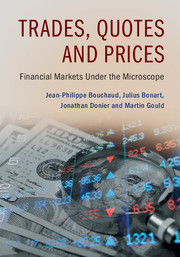Book contents
- Frontmatter
- Dedication
- Contents
- Preface
- Acknowledgements
- PART I HOW AND WHY DO PRICES MOVE?
- PART II LIMIT ORDER BOOKS: INTRODUCTION
- PART III LIMIT ORDER BOOKS: MODELS
- PART IV CLUSTERING AND CORRELATIONS
- PART V PRICE IMPACT
- PART VI MARKET DYNAMICS AT THE MICRO-SCALE
- PART VII ADVERSE SELECTION AND LIQUIDITY PROVISION
- PART VIII MARKET DYNAMICS AT THE MESO-SCALE
- 18 Latent Liquidity and Walrasian Auctions
- 19 Impact Dynamics in a Continuous-Time Double Auction
- 20 The Information Content of Prices
- PART IX PRACTICAL CONSEQUENCES
- Appendix
- Index
- References
18 - Latent Liquidity and Walrasian Auctions
from PART VIII - MARKET DYNAMICS AT THE MESO-SCALE
Published online by Cambridge University Press: 26 February 2018
- Frontmatter
- Dedication
- Contents
- Preface
- Acknowledgements
- PART I HOW AND WHY DO PRICES MOVE?
- PART II LIMIT ORDER BOOKS: INTRODUCTION
- PART III LIMIT ORDER BOOKS: MODELS
- PART IV CLUSTERING AND CORRELATIONS
- PART V PRICE IMPACT
- PART VI MARKET DYNAMICS AT THE MICRO-SCALE
- PART VII ADVERSE SELECTION AND LIQUIDITY PROVISION
- PART VIII MARKET DYNAMICS AT THE MESO-SCALE
- 18 Latent Liquidity and Walrasian Auctions
- 19 Impact Dynamics in a Continuous-Time Double Auction
- 20 The Information Content of Prices
- PART IX PRACTICAL CONSEQUENCES
- Appendix
- Index
- References
Summary
The world we live in is vastly different from the world we think we live in.
(Nassim N. Taleb)More than Meets the Eye
LOBs are designed to aggregate all the buy and sell limit orders from patient traders, so that they can be matched with the market orders of more hurried investors. It would therefore be easy to confuse the content of an LOB with the total supply and demand of a given asset at a given time. However, there are many reasons to believe that an LOB only reflects a tiny fraction of the true total supply and demand – which, for the most part, actually remain latent.
One argument for the existence of latent liquidity comes from examining LOB volumes and order flow. Recalling our discussion in Section 10.5, it is not uncommon for large players to seek to buy or sell a substantial fraction (say, a few tenths of a percent up to a few percent) of the total market cap of a given asset. Since the total outstanding volume in the LOB of a typical small-tick stock is roughly 10–3 of the market cap, and since the average daily volume (ADV) of trade is rarely above 0.5% of the market cap, such traders’ execution horizons must be on the scale of days to weeks. Therefore, at any given time, a large component of the supply or demand does not appear in the LOB, but instead reveals itself gradually.
Why do such traders not simply submit very large limit orders to the LOB? By doing so, they could clearly gain substantial queue priority. However, these limit orders would also signal to the rest of the market that a very large trader is present, and would immediately create price impact (remember again the dialogue at the beginning of Chapter 1). For small-tick stocks, this information leakage clearly outweighs the gain in queue priority. For larger-tick stocks, the total volume in the LOB is perhaps ten times larger, but is still just a small fraction of the ADV, so the drawbacks still far outweigh the benefits.
Another argument for the existence of latent liquidity concerns the shape of the LOB. As we saw in Chapter 4, real LOBs exhibit a hump-shape that first increases then decreases with increasing distance from the best quotes, and that eventually decays to zero at large distances.
- Type
- Chapter
- Information
- Trades, Quotes and PricesFinancial Markets Under the Microscope, pp. 337 - 353Publisher: Cambridge University PressPrint publication year: 2018



